The best Braves right fielder atlanta braves fanatics since 1990
September 15, 2022

Rounding out the position player “best of” series for the Atlanta Braves since 1990 is our look at right field. As with third base, right field has been one of the most consistent positions for the organization going back to the midst of the Great Depression, almost 100 years ago.
Whether you like one-year peaks, long runs of consistency, or just about anything in-between, right field has something for you. It also has is name value, because right field includes marquee-level star power throughout the years.
The Braves franchise history of right fielders includes one of the greatest offensive players in the history of the game … and I’m not talking about Hank Aaron, who is one of the greatest players to ever step foot on the diamond.
We will dive into the look at the best right fielders in this most-modern era of Braves baseball later in this article, but the position’s rich history means a more in-depth look at players who spent time with the Braves during the franchises’ Boston and Milwaukee eras, starting with Gene Moore, who took over the position in 1936.

The Boston Bees – yes, Bees – acquired Moore before the 1936 season in a trade with the Brooklyn Dodgers. In two stints with Boston, Moore slashed .284/.345/.429 across parts of five seasons, the best of which was his 1937 season when he was an All Star for the only time in his career.
Both his 1936 and 1937 season found him in the top 10 of a slew of offensive and defensive categories, including finishing first in the NL in Assists in right field in ‘36, ’37, and 1940 – and all outfielders in both ‘36 and ‘37. Offensively, he finished ‘36 and ‘37 in the top 10 in total bases, triples, home runs, and extra base hits.
After the 1938 season, the Bees trade Moore back to the Dodgers only to purchase him from them again on May 29, 1940. His return to Boston lasted only through the 1941 season, as the Braves (as they were called, again) traded him to the New York Yankees as the player-to-be-named when Boston acquired Tommy Holmes for Buddy Hassett.
Moore’s tenure with Boston produced 15.8 bWAR which peaked at 5.6 bWAR in 1937.
The trade for Holmes was one of the better trades in franchise history as Moore never played for the Yankees; the Dodgers purchase him from New York weeks after Moore became a Yankee. Hassett, who had been Boston’s primary first baseman, only played one season for the Yankees, posting 1.7bWAR in 1942 before enlisting in the U.S. Navy after breaking his thumb in the 1941 World Series. Although Hassett made the Yankees out of Spring Training in 1946, he didn’t appear in a game before the team released him, ending his career.
Holmes, had a stand-out Major League career across 11 seasons, all but one with the Braves, producing 36.0 bWAR for Boston. Holmes was a two-time All Star and received MVP votes in four seasons, including a second place finish as the team’s primary right fielder in 1945.
That ‘45 season was the best of Holmes’ career. He led the NL in hits, doubles, home runs, slugging, OPS , OPS+, and total bases. He also set the National League record by getting a hit in 37 consecutive games – a record that would later by broken by Pete Rose more than three decades later.
He finished the ‘45 season with a .352/.420/.577 slash line and 8.4 bWAR finishing behind the Chicago Cubs’ Phil Cavarretta for MVP. Holmes bested Cavarretta in all counting statistics, with Cavarretta leading the NL in batting average (Holmes finished second) and OBP, despite playing inMLB Pet Gear 22 games less than Holmes.
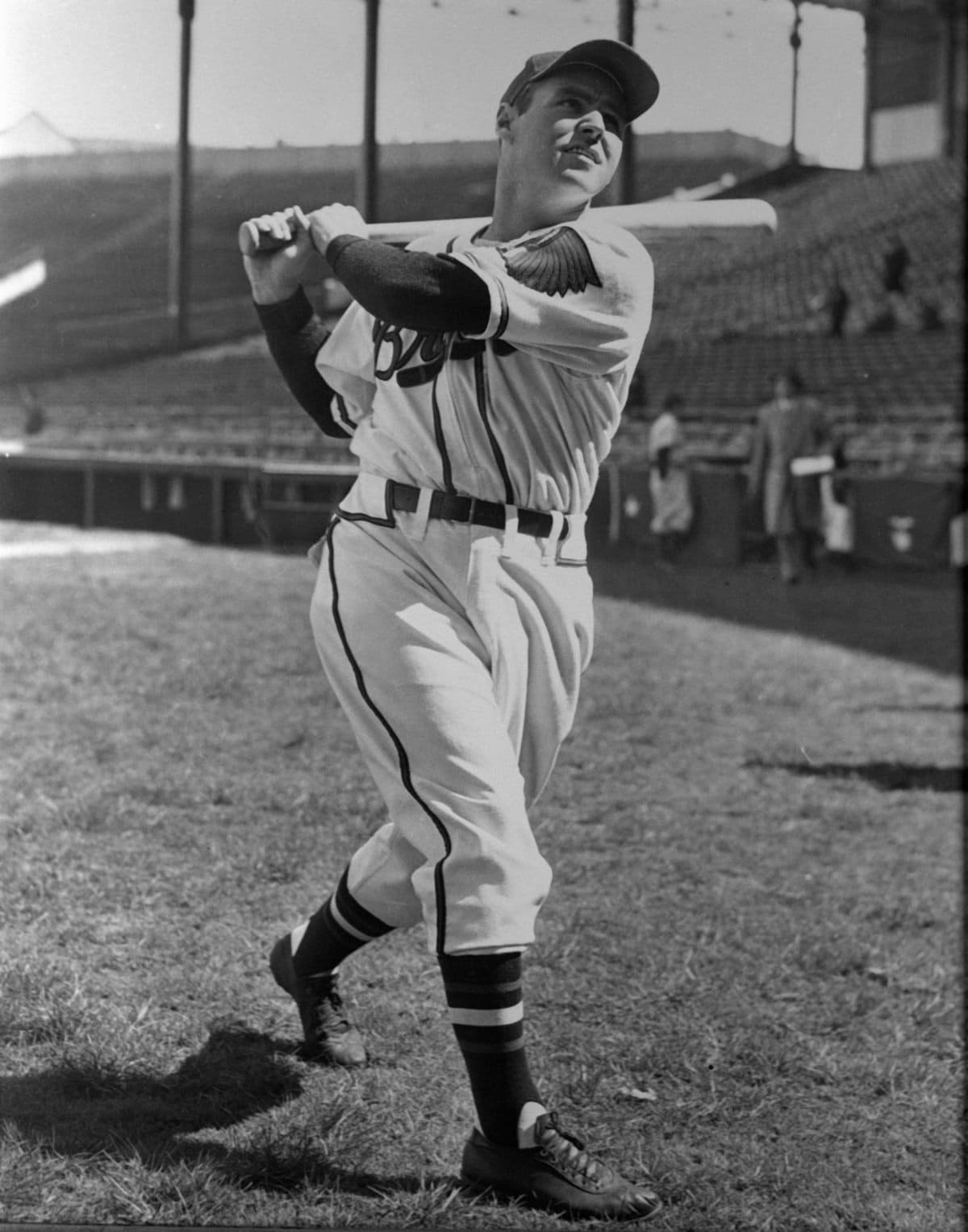
From 1942 to 1944, Holmes was Boston’s primary center fielder, shifting to right in 1945 where he would stay through the 1950 season. In 1951, the organization asked Holmes to take a job as a minor league player-manager. Midway through the ‘51 season, with the Major League team struggling, Holmes was summoned replaced Billy Southworth as Braves manager, with Holmes also serving a a pitch-hitter.
The 34-year-old was let-go as manager by Boston early in the 1952 season, despite posting an overall 61-69 record in what would end-up being his only Major League managing opportunity. He finished his playing career in ‘52 with the Dodgers.
Holmes spent most of his life in baseball – rejoining the Braves as a Minor League manager in 1953. For most of the rest of the decade, he coached in the Braves and Dodgers organizations. In 1959, he was named director of the New York Sandlot Baseball Alliance, a position he would hold for three decades. He later joined the New York Mets as director of amateur baseball relation in 1973, a position he would hold until the early 2000s.
With the Braves, Holmes slashed .302/.366/.432 across 1,320 games. Although he never reached double-digit home runs again in his career after 1945, he did led the NL in hits in 1947 and was an All Star in 1948. Between ‘44 and ‘48, Holmes never hit less than .309 in a season producing more than 190 or more hits in a season four times.
Like Moore, Holmes was an above-averMLB Small Jewelry age right fielder as he lead the NL in putouts as a right fielder twice – in 1946 and 1947. He finished in the top five at the position for both Putouts and Assists each season from 1945 through 1949.
Five years after Holmes’ last season as the primary right fielder, the Braves moved their burgeoning star – who had finished fourth in the 1954 Rookie of the Year balloting – from left field to right field.
What began in that 1955 season was the first of a record 25 All Star selection for one Henry Aaron. It was also the first season he wore his iconic number 44 after wearing number 5 his rookie season.
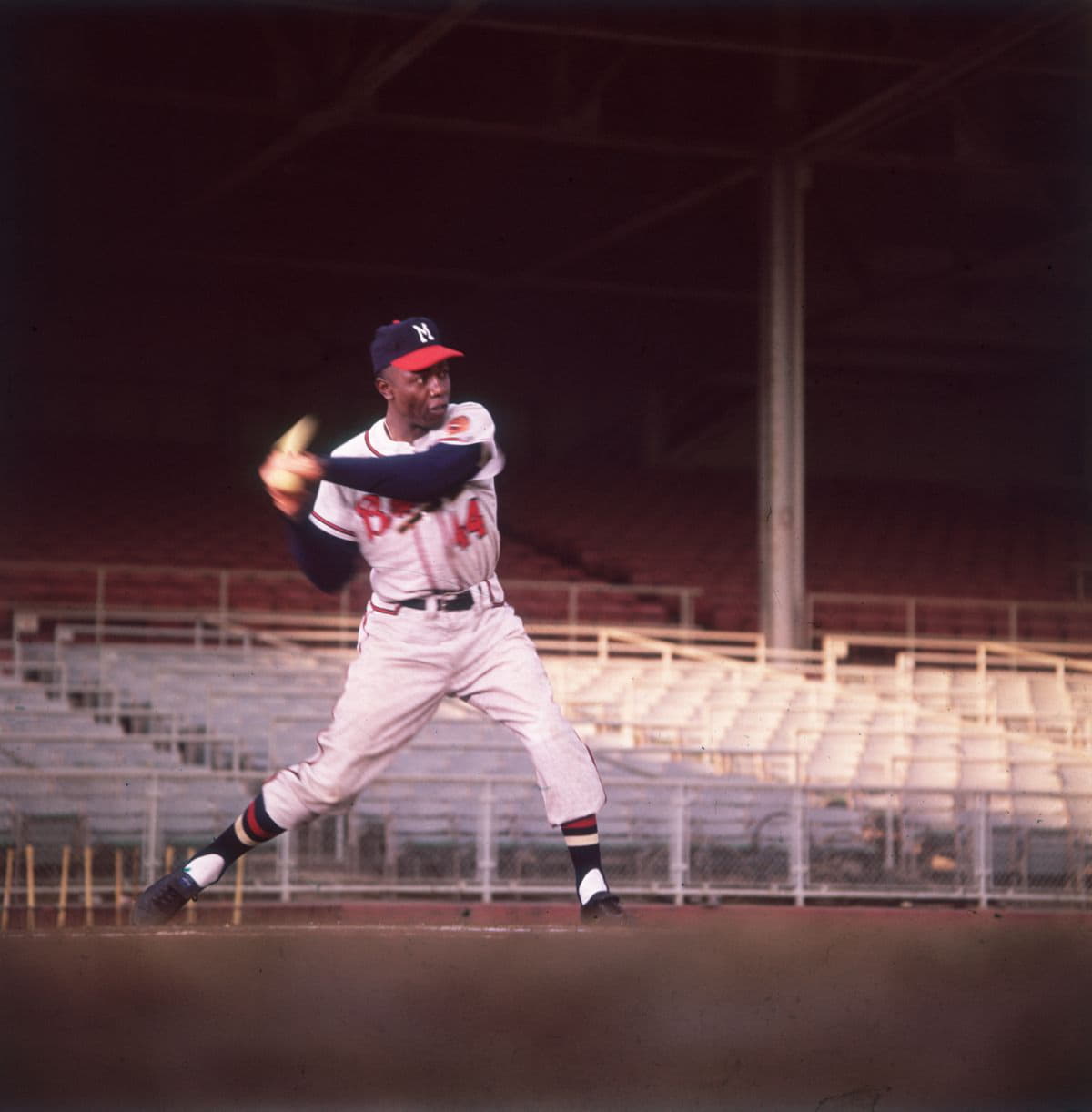
Hank Aaron is, without argument, one of the top 10 players in the history of the game. As a position player, he is in the discussion as the best ever, although certainly he is in the top five of any baseball historian’s list.
Aaron spend 20 of his 23 seasons in MLB with at least some time in right field. Over his 3,298 games played in his career, 2,174 of those including time in right. His next highest total was 315 games in left field – 105 of which were during his rookie season in ‘54.
Aaron’s career numbers are, obviously, legendary. He is still MLB’s all-time leader in RBI (2,297) and total bases (6,856). He finished his career with 3,771 Hits, 755 home runs, 2,174 runs, and a slash line of .305/.374/.555. His 143.0 bWAR is fifth all-time for positional players and seventh overall.
The only men ahead of him, at least according to our friends at Baseball-Reference, are Babe Ruth, Walter Johnson, Cy Young, Barry Bonds, Willie Mayes and Ty Cobb. Truly the elite of the elite.
From 1955 through 1970, Aaron was the team’s primary right fielder except for the 1961 and 1962 seasons when he split time between center field and right appearing in 83 games in center each season. In 1971, the team had him split time between first base and right field for two seasons before moving him to left field for his last two campaigns with Atlanta.
Aaron received MVP votes in 19 seasons – 18 of which he saw significant time as the team’s right fielder.
Using the 65 game mark that has been used throughout this series to qualify position players at a specific position, Aaron produced 123.2 bWAR in qualifying seasons in right field. That total would still place him 13th All Time in bWAR, just behind Eddie Collins and ahead of Ted Williams.
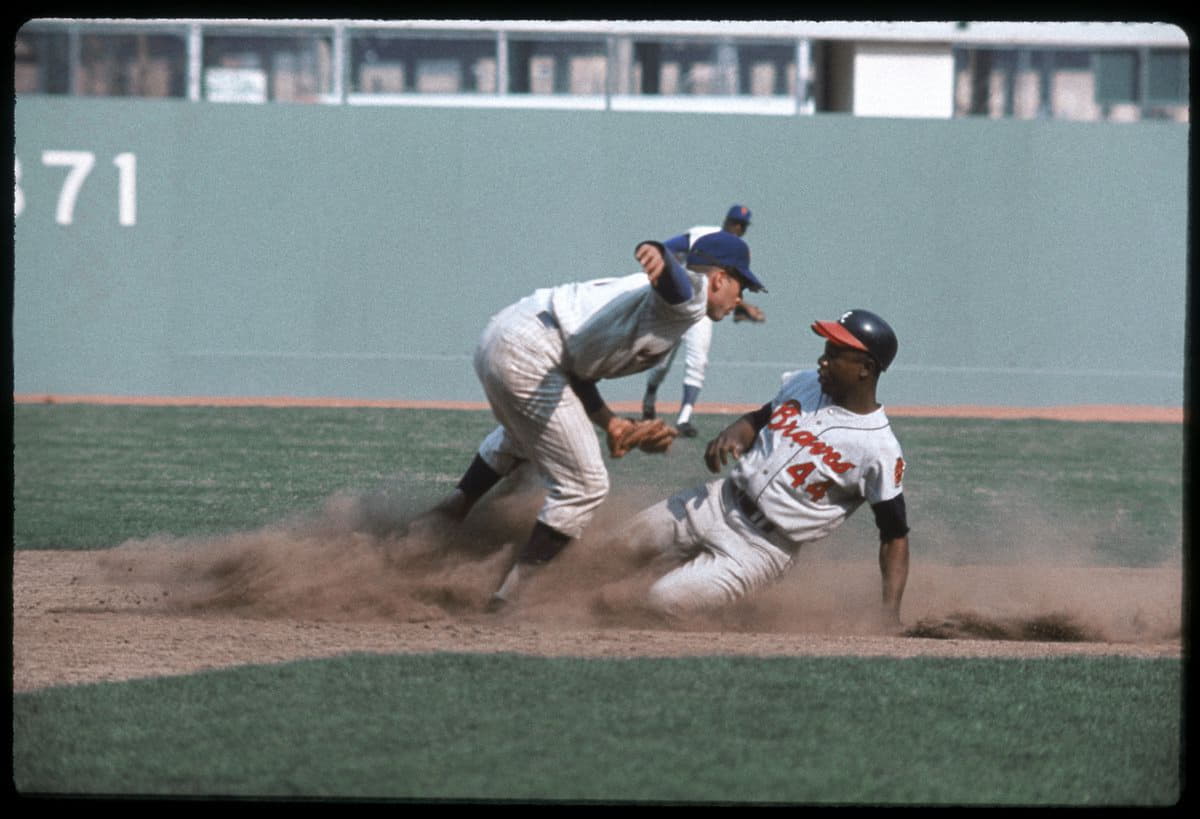
Defensively, Aaron won three Gold Gloves as a right fielder, finishing his career fourth All Time in both games played and putouts as a right fielder.
When the 37 year-old Aaron began his transition away from being team’s primary right fielder in 1971, Mike Lum spent the bulk of the atlanta braves jersey 3x time in ‘71 and ‘72.
Ralph Garr joined Lum in right field in ‘72, becoming the team’s primary fielder there in 1973. In 1974, Garr was the team’s primary center fielder, although he still saw a significant number of games in right. Garr led the NL in batting average, hits and triples during that All Star season for the “Roadrunner”.
It was Dusty Baker who found himself the team’s primary right fielder in 1974, a role in which he also held in 1975, the last season he spent with Atlanta.
Lum, Garr, and Baker all produced positive value out of the position in the first half of the decade. After a single season each from Ken Henderson and Jeff Burroughs, Gary Matthews took over in right field in 1978 where he would spend three seasons.
Matthews’ 1979 season was one of, if not the best, season of his career. The 1973 NL Rookie of the Year was selected as an All Star for the only time in his career in ‘79, when he slashed .304/.363/.502 and produced 4.4 bWAR as the team’s right fielder.
Beginning in 1981, Claudell Washington spent five seasons as the team’s primary right fielder. A high-priced free agent signing prior to the ‘81 season, the much-travelled Washington had burst on the scene as an All Star in 1975 for Oakland, after debuting for the A’s as a 19 year-old the season prior. After being traded to Texas in 1977, Washington played for the Chicago White Sox and New York Mets before Atlanta signed him after the 1980 season.
Washington was with the Braves until he was traded to New York Yankees mid-way through the 1986 season in a package the brought Ken Griffey, Sr. to Atlanta. Washington’s best season with Atlanta – and likely the best of his 17-year Major League career – came during the 1984 season when Washington was an All Star right fielder for the Braves. Although he played in only 120 games, he slashed .286/.374/.469 with a robust 130 OPS+.

In six seasons with the Braves. Washington played in 651 games with all but one game being in right field. An above average offensive player during those seasons, his outfield defensive was not an asset, with a -8.3 dWAR against a 10.3 oWAR.
In 1987, Dale Murphy shifted from centerfield to right field, and in doing so posted the best season by a player at that position since Hank Aaron in 1969.
Providing 7.7 bWAR for the season, Murphy was an All Star and finished 11th in the MVP voting in ‘87. Although he didn’t lead the league in any counting stats other than sacrifice flies, he did post a career-best 157 OPS+ that featured 44 home runs, 115 runs, 105 RBI, 115 walks, and a .295/.417/.580 slash line.
Establishing a career-best .997 OPS for the season, Murphy set career highs in home runs and walks to punctuate the end of six-straight season of All Star selections in 1987.
Unfortunately for Murphy, his 1988 season began a precipitous decline his MVP-era form. Although he still posted 3.3 bWAR and a 106 OPS+, his slash line fell to .226/.313/.421 with only 24 home runs and 77 runs and RBI in 156 games.
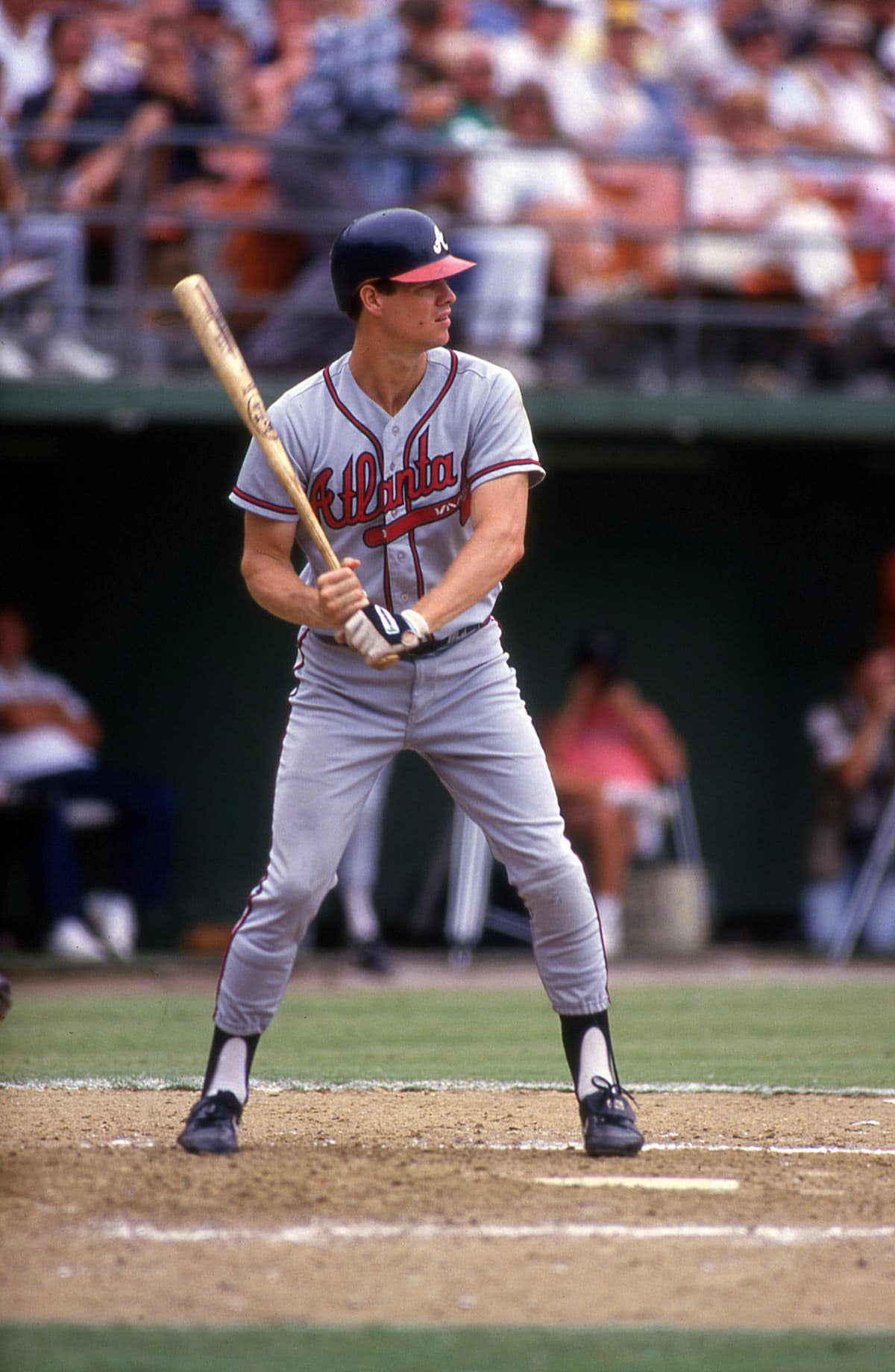
Murphy split time in the 1989 season between center and right, appearing in 82 games as a center fielder and 70 in right as the Braves languished in the nadir of their re-build. Murphy posted 1.6 bWAR with only a .228/.306/.361 slash line.
As was covered extensively in our review of center fielders, Murphy was a back-to-back NL MVP and one of the greatest position players of the 1980s. But his best offensive season may have been his 1987 season, which is still the second-best season for any Atlanta right fielder not named Hank Aaron.
Beginning our look at this most-modern era of Braves baseball in Atlanta kicks us off with the 1990 season, Murphy’s last in Atlanta.
As always, the data used in this retrospective is primarily from Baseball-Reference. While that isn’t everyone’s favorite statistical repository, it works just fine for this review. The only qualifier for this list is a minimum 65 games in a single season at the position being reviewed. For this reason, the 2020 season is omitted.
Best Single Seasons Since 1990
Here are the best single seasons by a right fielder for the Braves since 1990.
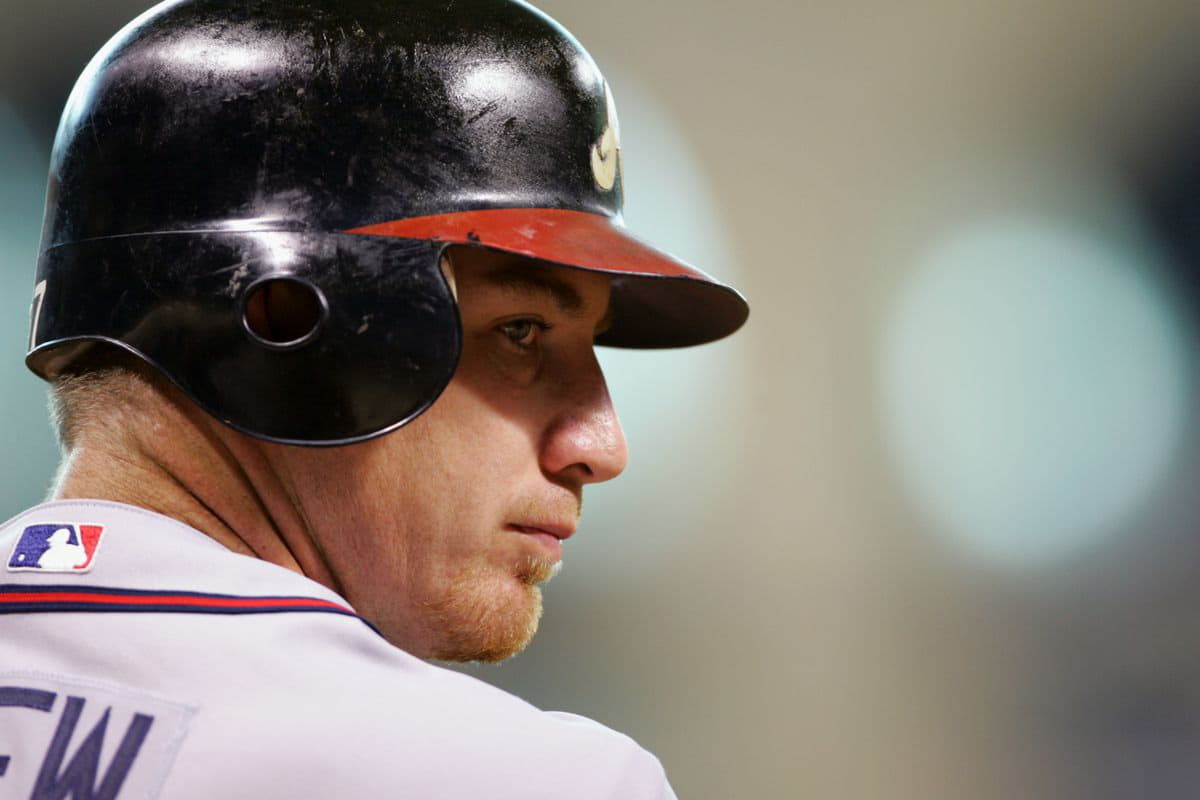
Top 5 Season, bWAR
J.D. Drew, 2004, 8.3
Gary Sheffield, 2003, 6.8
Jason Heyward, 2010, 6.4
Jason Heyward, 2012, 5.5
Jason Heyward, 2014, 5.5

Top 5 Seasons, by OPS+
Gary Sheffield, 2003, 162
J.D. Drew, 2004, 157
Ronald Acuna, Jr., 2021, 157
David Justice, 1994, 147
David Justice, 1991, 140
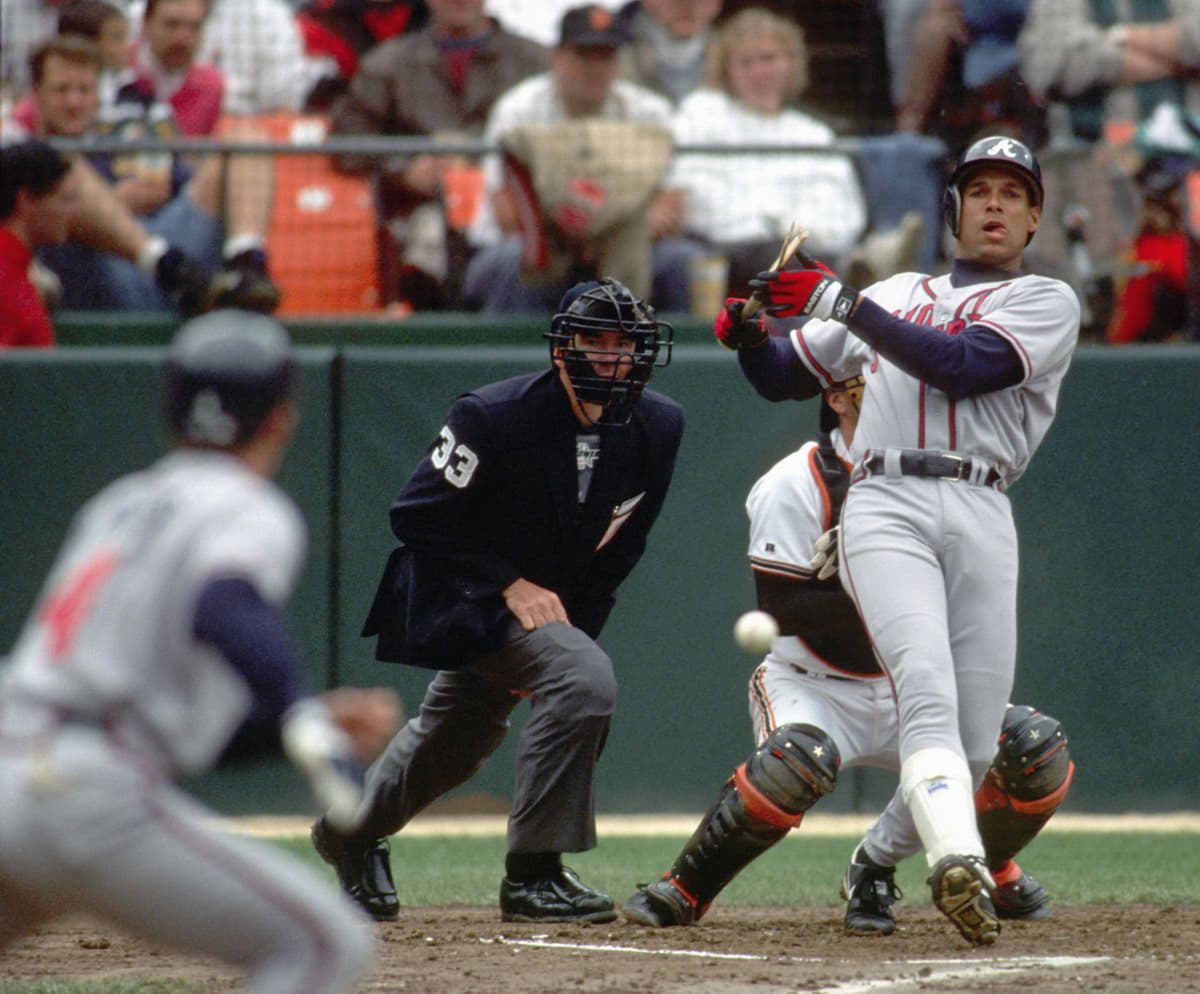
Top 5 Seasons, by HR
David Justice, 1993, 40
Gary Sheffield, 2003, 39
J.D. Drew, 2004, 31
Jeff Francoeur, 2006, 29
Jason Heyward, 2012, 27
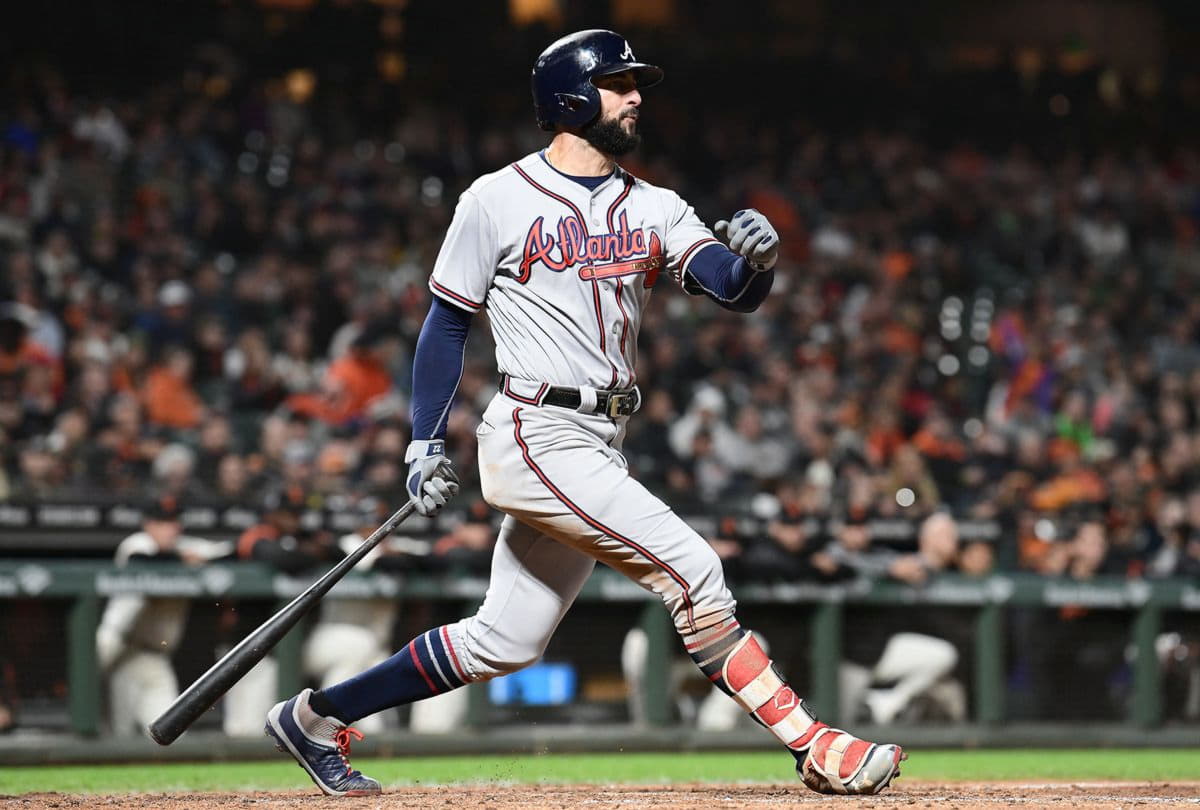
Top 5 Seasons, by 2B
Nick Markakis, 2018, 43
Jeff Francoeur, 2007, 40
Nick Markakis, 2017, 39
Nick Markakis, 2016, 38
Nick Markakis, 2015, 38
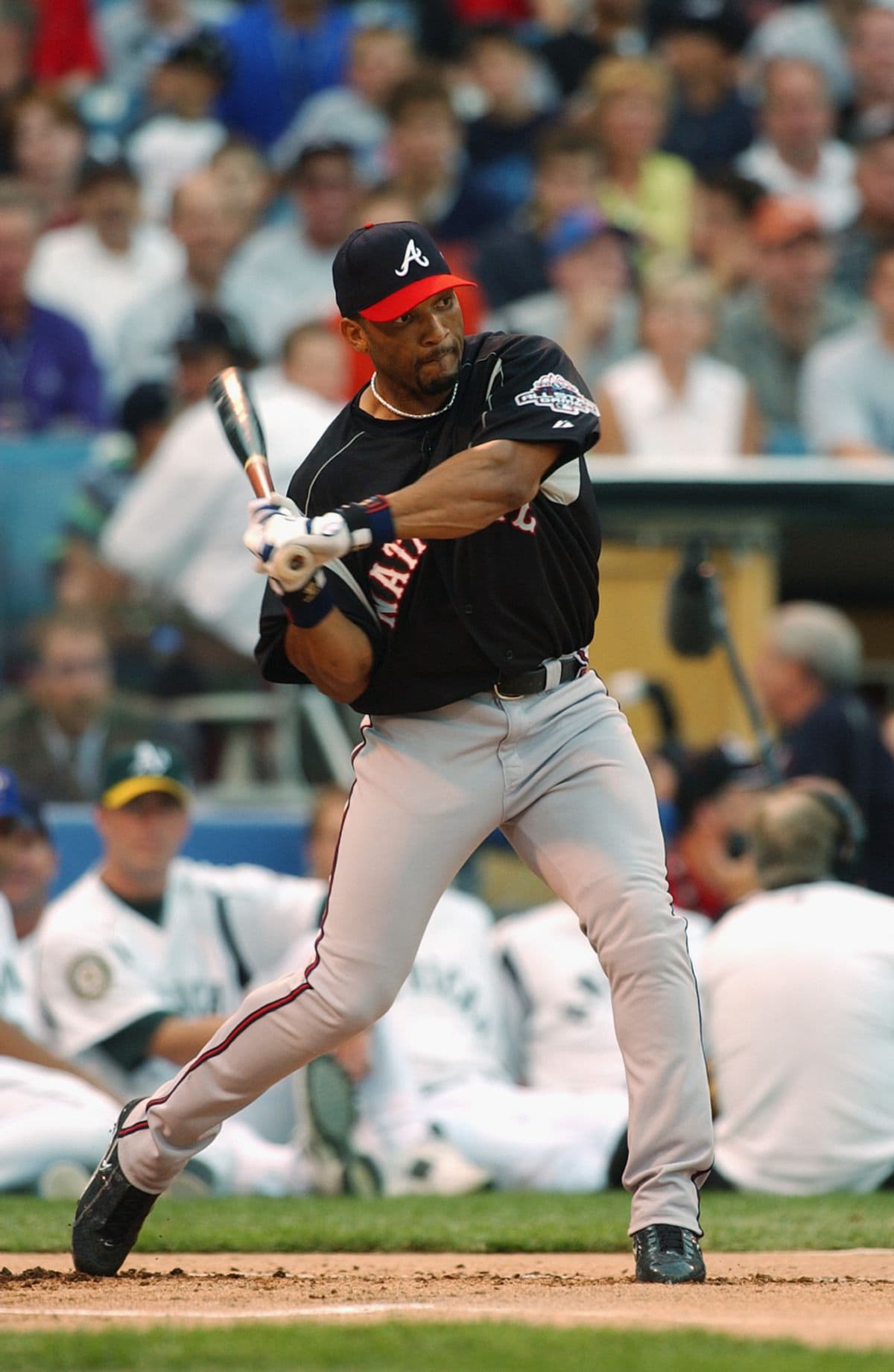
Top 5 Seasons, by RBI
Gary Sheffield, 2003, 132
David Justice, 1993, 120
Brian Jordan, 1999, 115
Jeff Francoeur, 2007, 105
Jeff Francoeur, 2006, 103
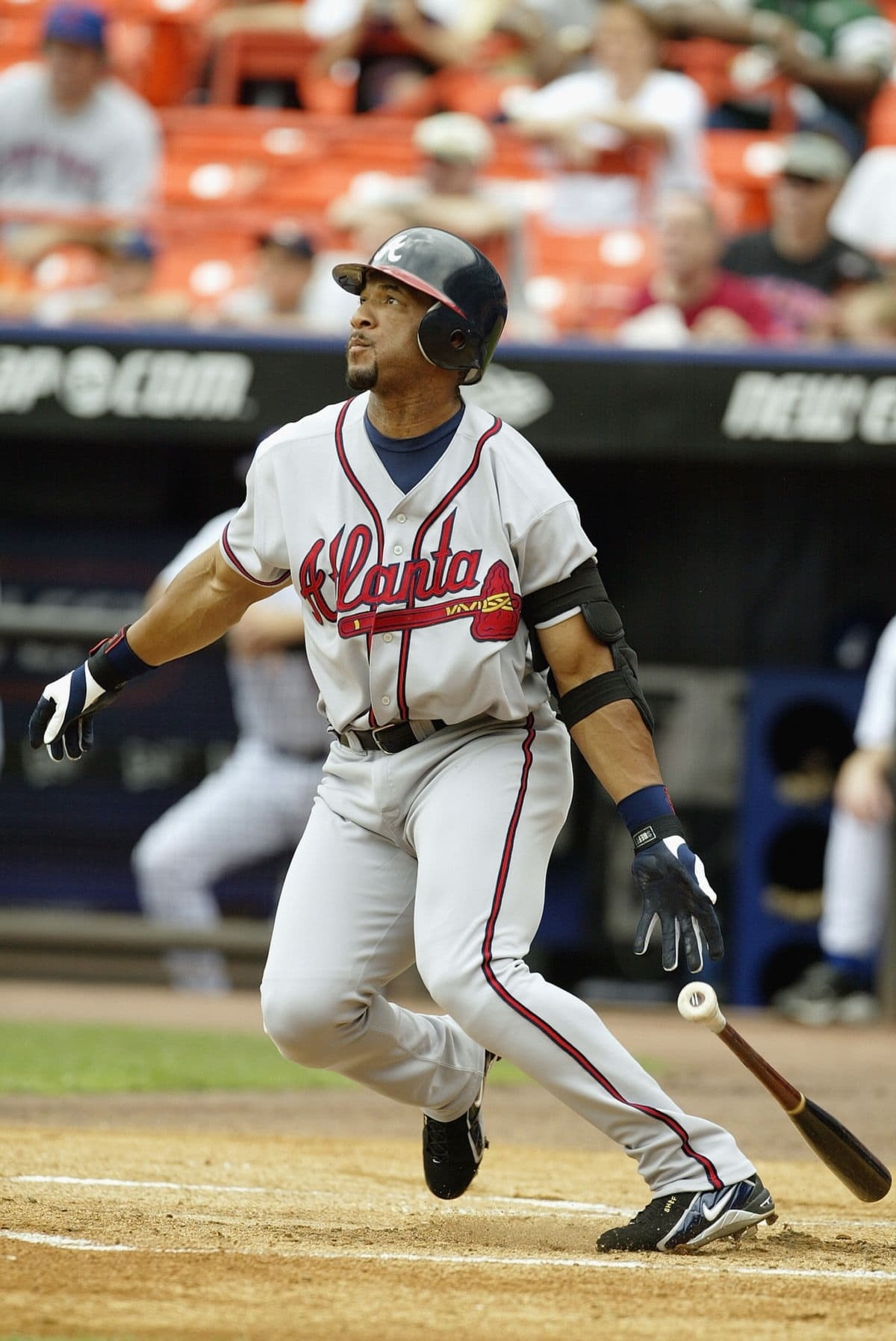
Top 5 Seasons, by Runs
Gary Sheffield, 2003, 126
J.D. Drew, 2004, 118
Brian Jordan, 1999, 100
Jason Heyward, 2012, 93
David Justice, 1993, 90

Top 5 Seasons, by OPS
Gary Sheffield, 2003, 1.023
J.D. Drew, 2004, 1.006
Ronald Acuna, Jr., 2021, .990
David Justice, 1994, .958
Gary Sheffield, 2002, .916

Top 5 Seasons, by BA
Gary Sheffield, 2003, .330
David Justice, 1994, .313
Matt Diaz, 2009, .313
Gary Sheffield, 2002, .307
J.D. Drew, 2004, .305

Top 5 Seasons, by SB
Jason Heyward, 2012, 21
Andruw Jones, 1997, 20
Jason Heyward, 2014, 20
Gary Sheffield, 2003, 18
Ronald Acuna, Jr., 2021, 17
Best Single Seasons by Decade
These are the best single seasons for right fielders per decade based on qualifying seasons only.
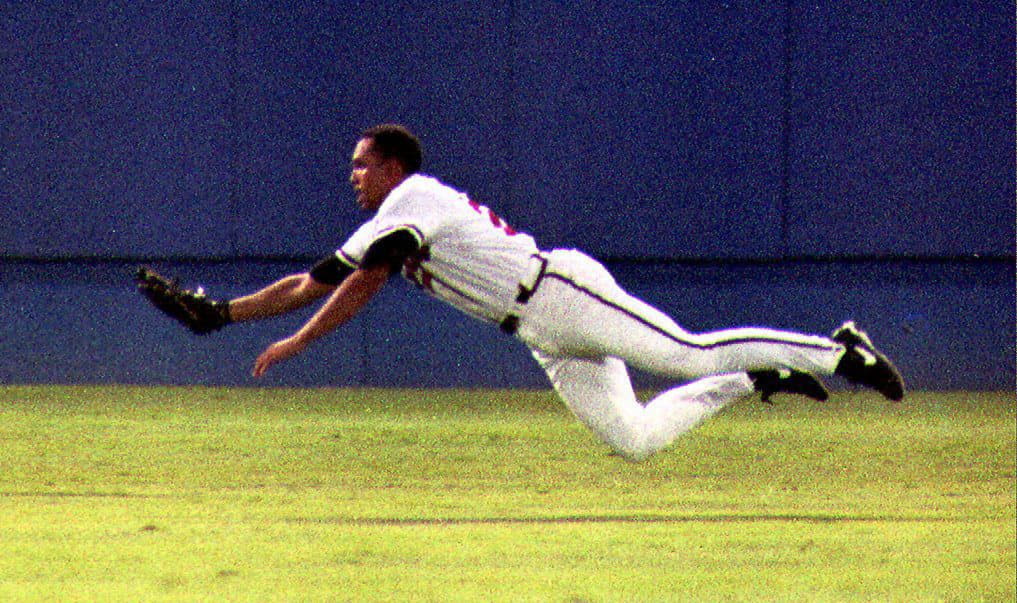
Top 5 bWAR, 1990s
David Justice, 1993, 5.1
David Justice, 1992, 4.9
David Justice, 1995, 3.8
David Justice, 1994, 3.7
Brian Jordan, 1999, 3.5
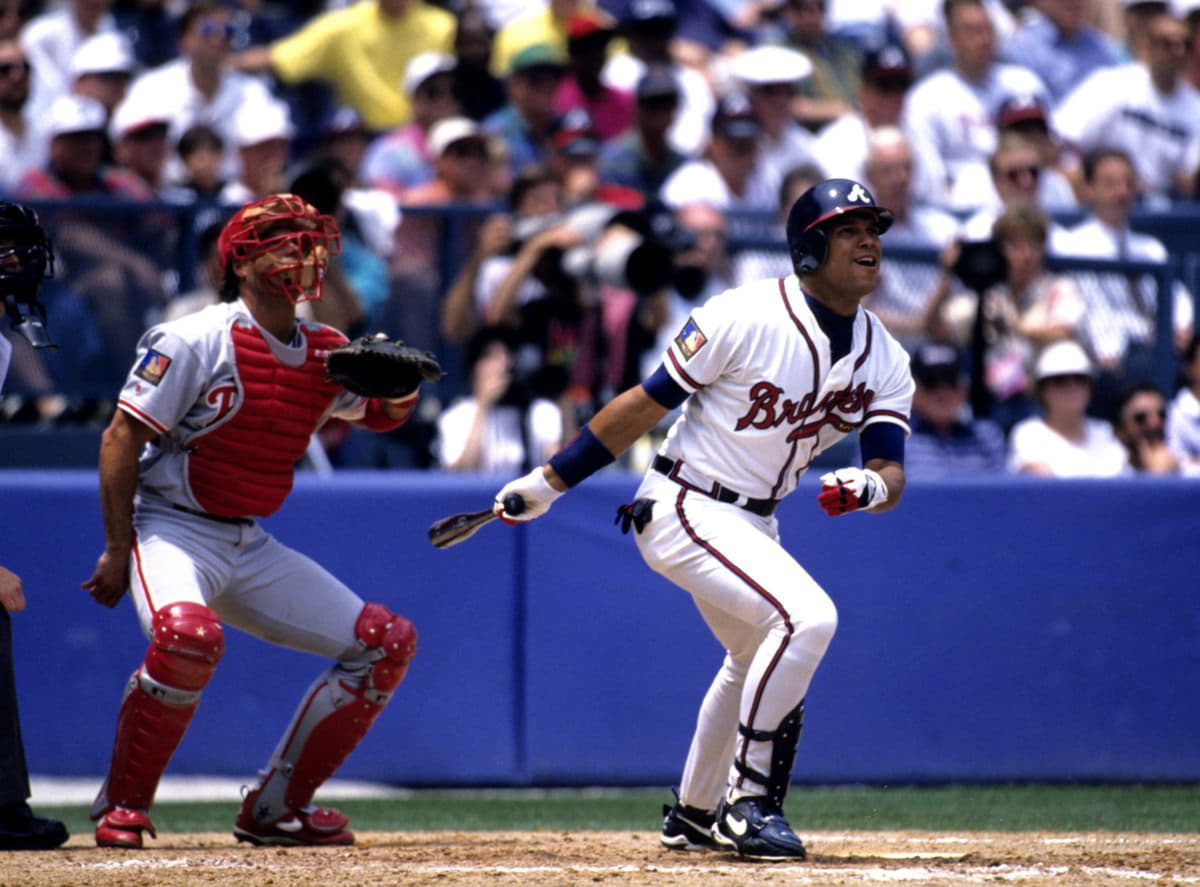
Top 5 OPS+, 1990s
David Justice, 1994, 147
David Justice, 1991, 140
David Justice, 1993, 131
David Justice, 1992, 121
David Justice, 1995, 118
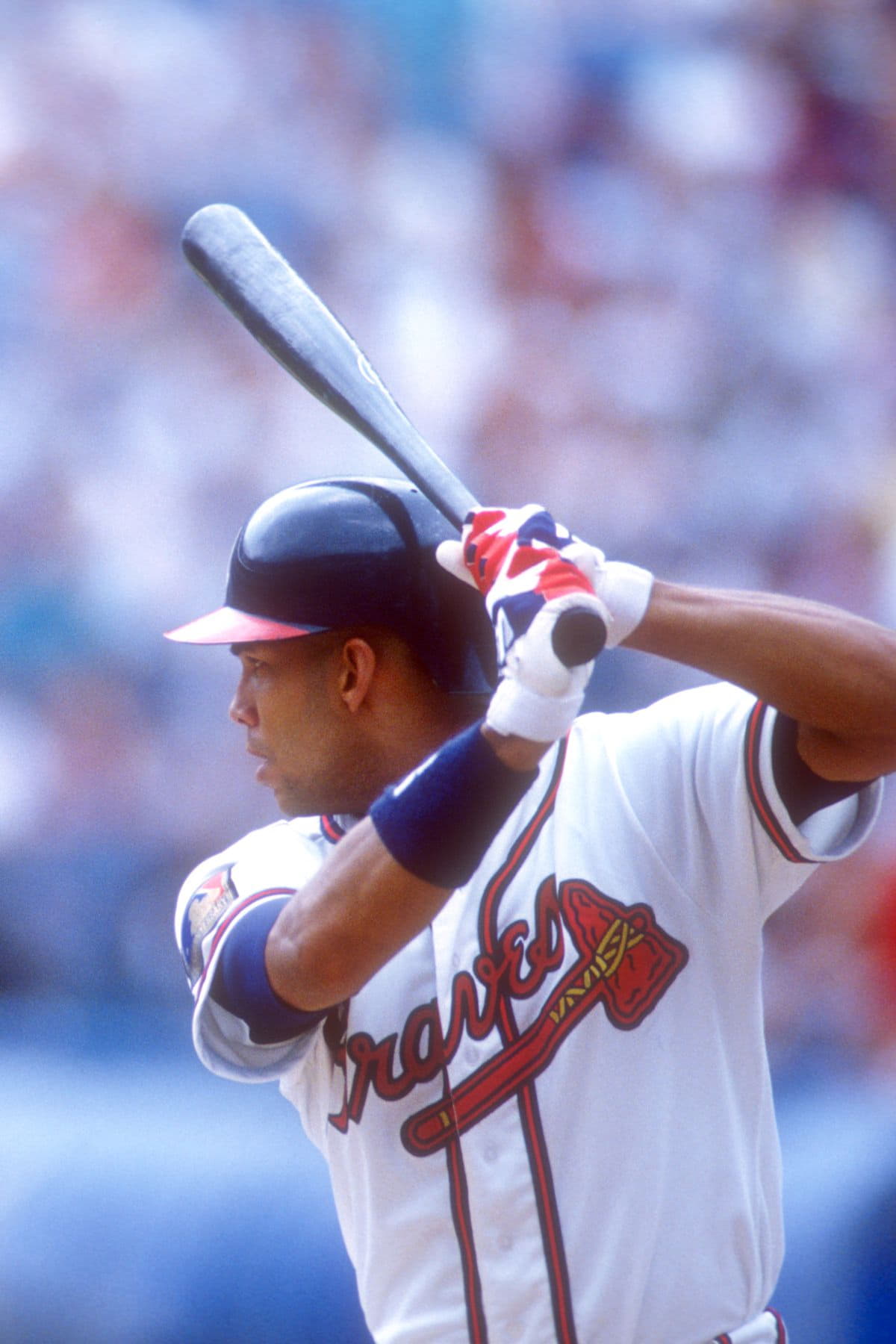
Top 5 BA, 1990s
David Justice, 1994, .313
Michael Tucker, 1997, .283
Brian Jordan, 1999, .283
Jermaine Dye, 1996, .281
David Justice, 1991, .275

Top 5 2B, 1990s
Brian Jordan, 1999, 28
Michael Tucker, 1998, 27
David Justice, 1991, 25
Michael Tucker, 1997, 25
David Justice, 1992, 18

Top 5, HR, 1990s
David Justice, 1993, 40
David Justice, 1995, 24
Brian Jordan, 1999, 23
David Justice, 1991, 21
David Justice, 1992, 21

Top 5 bWAR, 2000s
J.D. Drew, 2004, 8.3
Gary Sheffield, 2003, 6.8
Gary Sheffield, 2002, 4.4
Brian Jordan, 2001, 4.3
Jeff Francoeur, 2007, 3.3

Top 5 OPS+, 2000s
Gary Sheffield, 2003, 162
J.D. Drew, 2004, 157
Gary Sheffield, 2002, 138
Matt Diaz, 2009, 132
Jeff Francoeur, 2005, 126

Top 5 BA, 2000s
Gary Sheffield, 2003, .330
Matt Diaz, 2009, .313
Gary Sheffield, 2002, .307
J.D. Drew, 2004, .305
Jeff Francoeur, 2005, .300

Top 5 2B, 2000s
Jeff Francoeur, 2007, 40
Gary Sheffield, 2003, 37
Jeff Francoeur, 2008, 33
Brian Jordan, 2001, 32
J.D. Drew, 2004, 28

Top 5 HR, 2000s
Gary Sheffield, 2003, 39
J.D. Drew, 2003, 31
Jeff Francoeur, 2006, 29
Brian Jordan, 2001, 25
Gary Sheffield, 2002, 25

Top 5 bWAR, 2010s
Jaso atlanta braves gray jersey n Heyward, 2010, 6.4
Jason Heyward, 2014, 5.5
Jason Heyward, 2012, 5.5
Jason Heyward, 2013, 3.6
Nick Markakis, 2018, 2.6

Top 5 OPS+, 2010s
Jason Heyward, 2010, 131
Jason Heyward, 2012, 117
Nick Markakis, 2018, 116
Jason Heyward, 2013, 114
Jason Heyward, 2014, 109
Nick Markakis, 2015, 109

Top 5 BA, 2010s
Nick Markakis, 2018, .297
Nick Markakis, 2015, .296
Nick Markakis, 2019, .285
Jason Heyward, 2010, .277
Nick Markakis, 2017, .275

Top 5 2B, 2010s
Nick Markakis, 2018, 43
Nick Markakis, 2017, 39
Nick Markakis, 2015, 38
Nick Markakis, 2016, 38
Jason Heyward, 2012, 30

Top 5 HR, 2010s
Jason Heyward, 2012, 27
Jason Heyward, 2010, 18
Jason Heyward, 2011, 14
Jason Heyward, 2013, 14
Nick Markakis, 2018, 14
Best Cumulative Qualifying SeMLB Baby Clothing asons
These are the best cumulative totals from qualifying season for Atlanta’s right fielders since 1990.

Top 5 bWAR, Qualifying Seasons
Jason Heyward, 22.9
David Justice, 19.1
Gary Sheffield, 11.2
Brian Jordan, 9.8
J.D. Drew, 8.3

Top 5 HR, Qualifying Seasons
David Justice, 125
Jason Heyward, 84
Jeff Francoeur, 78
Brian Jordan, 65
Gary Sheffield, 64

Top 5 RBI, Qualifying Seasons
David Justice, 416
Nick Markakis, 373
Jeff Franceour, 359
Jason Heyward, 292
Brian Jordan, 289

Top 5 Games, Qualifying Seasons
Nick Markakis, 720
Jason Heyward, 651
David Justice, 625
Jeff Francoeur, 623
Brian Jordan, 424
Youngest and Oldest Qualifiers

Top 5 Youngest
Andruw Jones, 1997, 20
Jayson Heyward, 2010, 20
Jeff Francoeur, 2005, 21
Jason Heyward, 2011, 21
Jermaine Dye, 1996, 22
Jeff Francoeur, 2006, 22
Jason Heyward, 2012, 22

Top 5 Oldest
Nick Markakis, 2019, 35
Dale Murphy, 1990, 34
Brian Jordan, 2001, 34
Gary Sheffield, 2003, 34
Nick Markakis, 2018, 34
Right Field Buffet

The great thing about buffets is they offer a little something for everyone. Don’t like the beef tips? Get the fried chicken. Don’t eat meat? There are a copious number veggies – although warning, they might be ladened with butter, meat, and sneezes.
Regardless, it is all about that soft-serve ice cream machine – you know that, I know that, and of course the Braves know that.
The last three decades of right fielders gave you a lot choices, that’s for sure.
Want a one-year rental who had a generationally great season? You’ve got that in J.D. Drew.
Would you prefer a veteran slugger whose hard-hit rate and exit velocity numbers would have surely been at the top of his generation? Gary Sheffield was that dude.
Or maybe your thing is young prospects whose initial splash was their high-water mark? Take your pick between Jeff Francoeur and Jason Heyward.
How about an out-spoken outfielder who replaced a franchise legend and went on to hit one of the most important World Series home runs in team history? David Justice is there for you.

Want a two-sport athlete to roam right? Brian Jordan was an All Star for the Braves and a Pro Bowl alternate as a safety for the Falcons.
Maybe you just like doubles.
Order a drink? Make it a double. Order a burger? Make it a double. Need to take the edge off with an ice cream cone? Make it a double. Need a right fielder? Sounds like you’d make it a Nick Markakis.
If you only care about the here-and-now, Ronald Acuna, Jr.’s knee injury might make you worry. But even so, he’s shown that he could be the guy in right for another four or five years, at least.
Unlike a lot of the other position player retrospectives, right field didn’t have one player who stood out head-and-shoulders above the rest. As you saw above, and will read below, since 1990 the Braves have rolled out numerous, notable players.
Such an even distribution of talent makes it challenging to crown one player as the best single player at the position, so let’s start with three and work our way from there.
The Final Three
Jason Heyward spent five seasons in right field and created the most bWAR of the group with 22.9. Heyward was a positive offensive contributor for Atlanta, but his defensive contribution was a key component of his overall value. His rookie year was his best with Atlanta, as he was an All Star and finished second in the Rookie of the Year award. He totaled 651 games in right field, behind Nick Markakis and just ahead of the next person in this list of three.
David Justice produced 19.1 bWAR in qualifying season as part of this retrospective, playing in 625 games in right field. Justice won the Rookie of the Year in the NL in 1990, but only appeared in 60 games in right field as he was the team’s primary first baseman until Dale Murphy was traded. Justice and Heyward were different sides of the same coins – highly touted prospects who provided All Star level production, with Justice being better offensively than Heyward – who was better defensively.

The other contender here, to me, is Gary Sheffield. Although J.D. Drew generated 8.3 bWAR in 2004 – with above average defensive – Sheffield’s offensive production exceeded that of anyone on this list. Sheffield was known for his bat – not his glove – as seen by a career -27.7 dWAR across shortstop, third base, and the outfield. His bat was special, though.
In 280 games as the team’s right fielder, Sheffield created 11.2 bWAR, with his offensive production in 2003 being the best of any player in this list – including an outstanding 1.023 OPS in 2003. Although he only played in two seasons with Atlanta he had the third highest bWAR total of all right fielders, helped by averaging 32 home runs, 104 runs, 108 RBI, and 15 steals in those two seasons.
Sheffield hasn’t yet been elected into Baseball’s Hall of Fame, in large part due to his involvement with the scandals related to performance enhancing drugs. He spent 22 seasons in the Majors, beginning as a 19 year-old shortstop for the Milwaukee Brewers in 1988. When his career ended after the 2009 season – after playing in 100 games for the New York Mets at age 40 – he had amassed 509 home runs, 2,689 hits, 253 stolen bases, scored 1,636 runs, and delivered 1,676 RBI. He slashed .292/.393/.514 for his career – one which saw him walk 304 more times than he struck out.
He played in almost twice as many games in the National League than American League, with the peak of his career starting in 1992 wShohei Ohtani ith the San Diego Padres, followed by 10 years split between the Florida Marlins and Los Angeles Dodgers, two seasons with Atlanta, and three seasons with the New York Yankees. That 14 year run of dominance included nine All Star selections, five Silver Slugger Awards, and seven seasons garnering votes for MVP – including three top 3 finishes in 1992, 2003, and 2004.
For reference on how good Sheffield was offensively, he ranks 21st All Time in Win Probability Added (WPA), just below Chipper Jones and ahead of Al Kaline. Of players eligible for the Hall of Fame, he is the highest ranked player not in the Hall who isn’t named Barry Bonds (who is first, all time, by the way).
If this were about picking the best player to player right field for the Braves – including his overall career – Sheffield would be tops. And I thought long-and-hard about giving him the top spot in this list despite only playing two seasons with Atlanta. Ultimately, his time with Atlanta wasn’t long enough to justify the top spot.
That leaves five seasons each of Heyward and Justice battling for the top spot.
The Case for Justice

While Heyward’s bWAR gives him the edge over Justice based on qualifying seasons, Justice is my selection as the top right fielder since 1990.
I am not alone in that thinking.
In an unscientific poll I posted prior to the release of this article, out of 501 votes, 49-percent of the respondents voted for David Justice as the best right fielder since 1990. Gary Sheffield (25-percent), Nick Markakis (16-percent), and Jason Heyward (10-percent), rounded out the voting in the limited-to-four-options poll.
There are a few reasons why I ended up with Justice in the top spot. Beyond his accumulated statistics, he also provided 14.4 WPA, and according to Fangraphs, his wRC+ ranged between 120 and 151 in his five qualifying seasons. He was a slightly above average defensively as an outfielder, so while he wasn’t as good as Heyward, he was far from the liability that Sheffield was.
I also could not overcome my own bias on Justice’s perceived postseason impact. In 112 postseason games during his career, he was actually a below average offensive performer. He slashed only .224/.335/.382 with a -30.8% cWPA. However, with Atlanta, his postseason moments in both the NLCS and World Series jumps out for anyone who lived through that era – especially his 1992 NLCS and 1995 World Series performances. He posted positive cWPA in both of his World Series winning seasons: 20.3% in 1995 and 0.1% in 2000.
As the team’s primary right fielder, Justice was an All Star twice, a Silver Slugger, and finished third in the 1993 NL MVP vote. In 1996, he was off to a blistering start to the season, when a shoulder injury ended his season in May.
That ‘96 season would be his last season with the Braves as he was traded to Cleveland before the 1997 and would have the best season of his career with the then-Indians winning the Silver Slugger, being named an All Star for the final time in his career and finishing fifth in the AL MVP.
He was traded by Cleveland to the New York Yankees in 2000, helping to power the Yankees to the World Series Championship after hitting 41 home runs between the two clubs during the regular season and being named MVP of the ALCS.
He wrapped up a 14-year career with Oakland in 2002 at age 36 having generated 40.4 bWAR for his career while hitting 305 home runs with a .279/.378/.500 slash line and a 129 OPS+.
As for the other guys who didn’t make this list, although Jeff Francoeur had a couple of good seasons he also the two of the worst seasons of any right fielder.
Nick Markakis was reliable during his five seasons in right field – never bad and always good, but he never had a great season with Atlanta. That sounds like a back-handed compliment but it isn’t. He was an a solid performer as the Braves completed their rebuild.
Brian Jordan spent three seasons in right field for Atlanta and was an above average performer – specially his 1999 and 2001 seasons. His 2001 season is easy to overlook in the 2000s because of how great Sheffield and J.D. Drew were in the following three seasons.
Notable Tidbits

Here is a look at some of the interesting notes for right fielders since 1990.
Only two seasons had more than one right fielder qualify in this ranking, speaking to the high level of performance the team has had in the last three decades at the position. Andruw Jones and Michael Tucker (1997) and Jeff Francoeur and Matt Diaz (2009) were the players who qualified in a single season. The tandem in the 1997 season (6.1 bWAR) dominated those in the 2009 season (1.4 bWAR) in overall impact.Only five players appeared in a single season: Dale Murphy (1990), Jermaine Dye (1996), J.D. Drew (2004), Matt Diaz (2009), and Ronald Acuna, Jr. (2021).Acuna, Jr.’s only season as a qualified player was last year, when he only played in 80 games due to injury. With 24 home runs, 52 RBI, and 3.6 bWAR in half-a-season, it is easy to dream how goods his totals might have been had he been healthy all season.Since 1990, right fielders produced 97.1 bWAR of total output.The constancy of excellence shows up in the per-decade total with the 1990s providing 30.5 bWAR, the 2000s besting that with 32.4 bWAR, and the 2010s leading with 34.2 bWAR.There were only two seasons with a player averaging negative bWAR – 2008 (-1.7) and 2009 (-0.3) – both by Francoeur.Right field has stereotypically been a power position, and that holds true for the Braves. Since 1990, qualifying players combined for 605 home runs.Only four seasons saw a qualifying player not exceed 10 home runs – Francoeur in 2009 and Nick Markakis in 2015, 2017, and 2019.When it comes to total bases, Gary Sheffield paced right fielders with 348 in 2003. David Justice also exceeded 300 with 301 in 1993.Four players qualified in five seasons: Justice, Francoeur, Heyward, and Markakis.There were eight players to qualify in right field who played in less than 100 games. The fewest was 66 games from Matt Diaz, who also played in 50 games in left field that season.Jeff Francoeur was the only player to to appear in 162 games in right field. He did so twice in 2006 and 2007.Eleven players played in 150 games or more in right field, led by Markakis (4) and Francoeur (3). Justice, Heyward, Sheffield, and Jordan rounded out the group.

J.D. Drew had what may be the best single season of any right fielder since 1990. As good as he was in 2004, his tenure has always been tainted because of the cost the Braves paid to bring him to Atlanta.
The Braves traded reliever Ray King, starting pitcher Jason Marquis, and top starting pitching prospect Adam Wainwright to the St. Louis Cardinals for Drew and catcher/outfielder Eli Marrero after the 2003 season.
Although Drew (8.3 bWAR) and Marrero (2.3bWAR) combined for 10.6 bWAR in their only seasons with Atlanta and Marquis was up-and-down in three seasons with the Cardinals, Wainwright has gone on to collect 47.3 bWAR (though 9/10/22).
Wainwright may retire after this season, but has won almost 200 games with the Cardinals in a career than includes three All Star selections, four top three NL Cy Young finishes, and more than 2,500 innings pitched in his career.
That’s a high price to pay for one season of Drew, who left Atlanta to sign as a free agent with the Dodgers after the ‘04 season. For Drew, 2004 was the only season of his career in which he received MVP votes – finishing sixth.
Ultimately, based on bWAR, Drew had the second best season by any Atlanta Braves right fielder, training only Hank Aaron’s 1967 season when Aaron posted 8.5 bWAR for the season.
As for the current – and future – of right field, it should be Ronald Acuna, Jr.’s for at least the balance of his current contract. Although he has struggled, by his standard, in his return from the knee injury that cost him the last-half of the 2021 season, he may very well be the best right fielder to play the position since 1990 with a few more qualifying seasons.
More From
Braves News: Braves go down quietly in game two, Ronald Acuña Jr. remains out, more Tough matchup plays out as expected as Braves lose 9-1 to Phillies Braves @ Phillies GameThread: 9/23/2022 Ronald Acuña Jr. remains out, Michael Harris II moves up to second as Braves take aim at Aaron Nola MLB Toys Braves look to bounce back Friday against the Phillies Braves Minor League Recap: Justyn-Henry Malloy keeps hitting